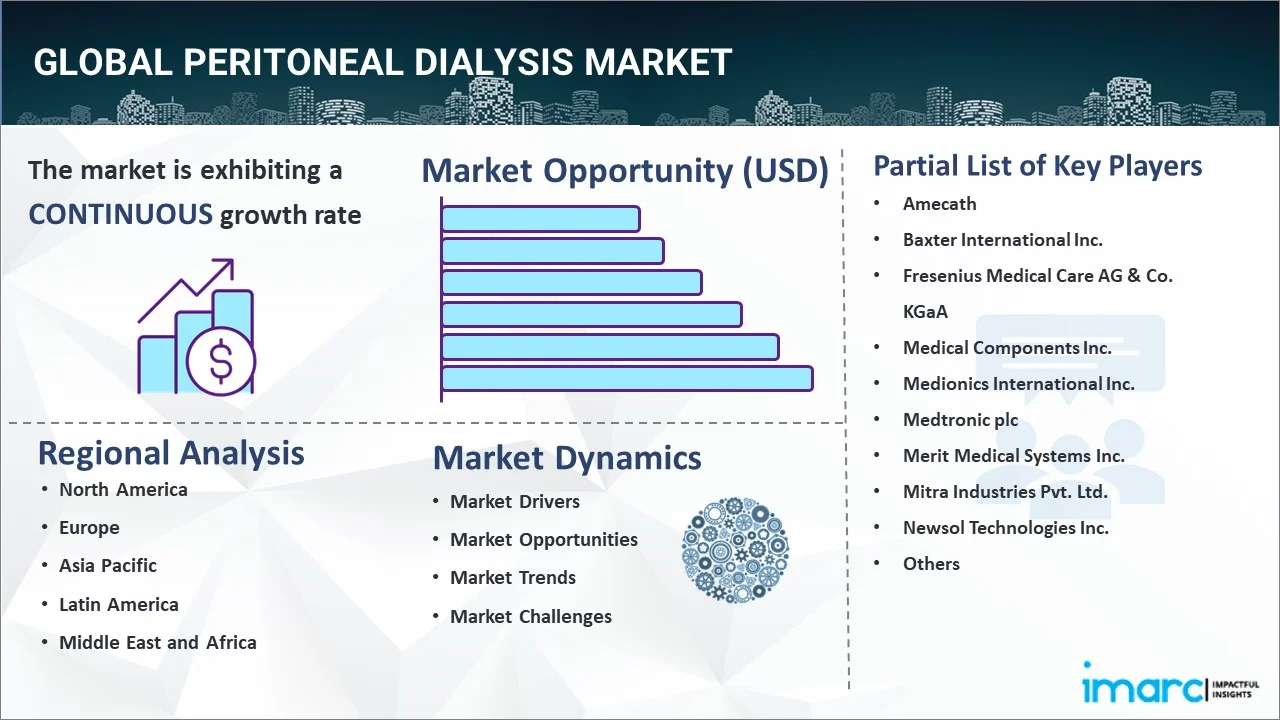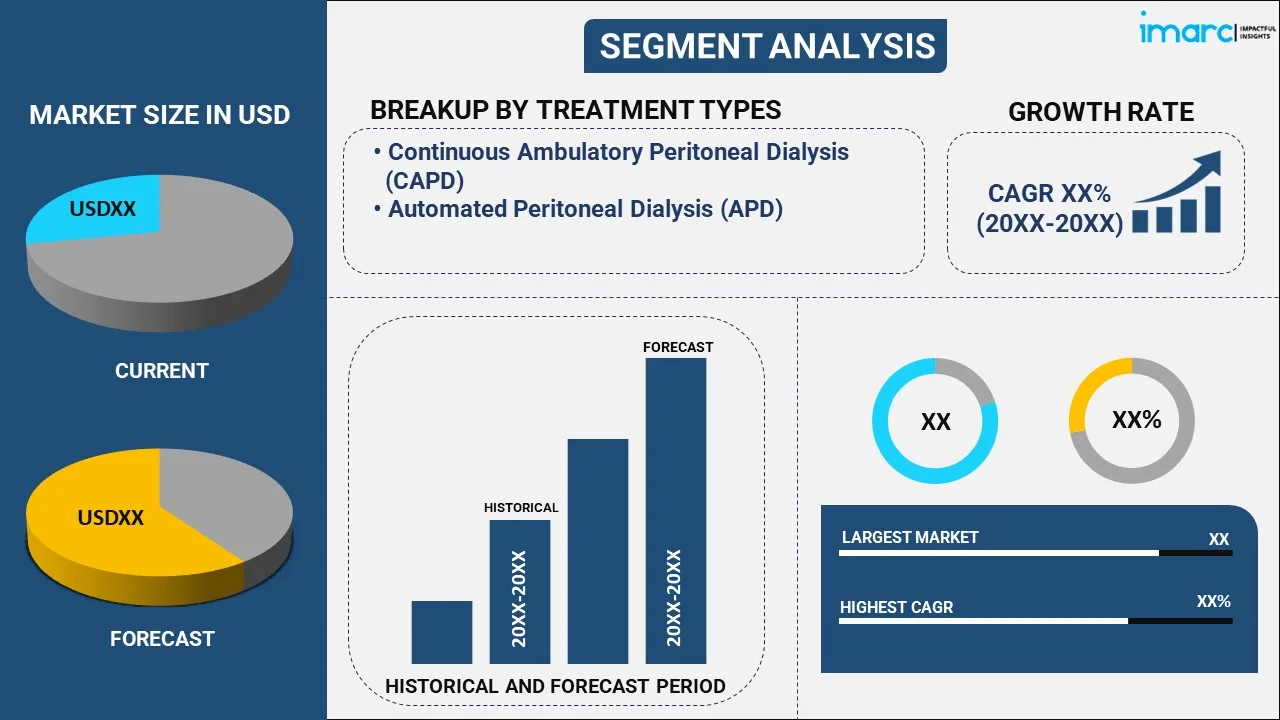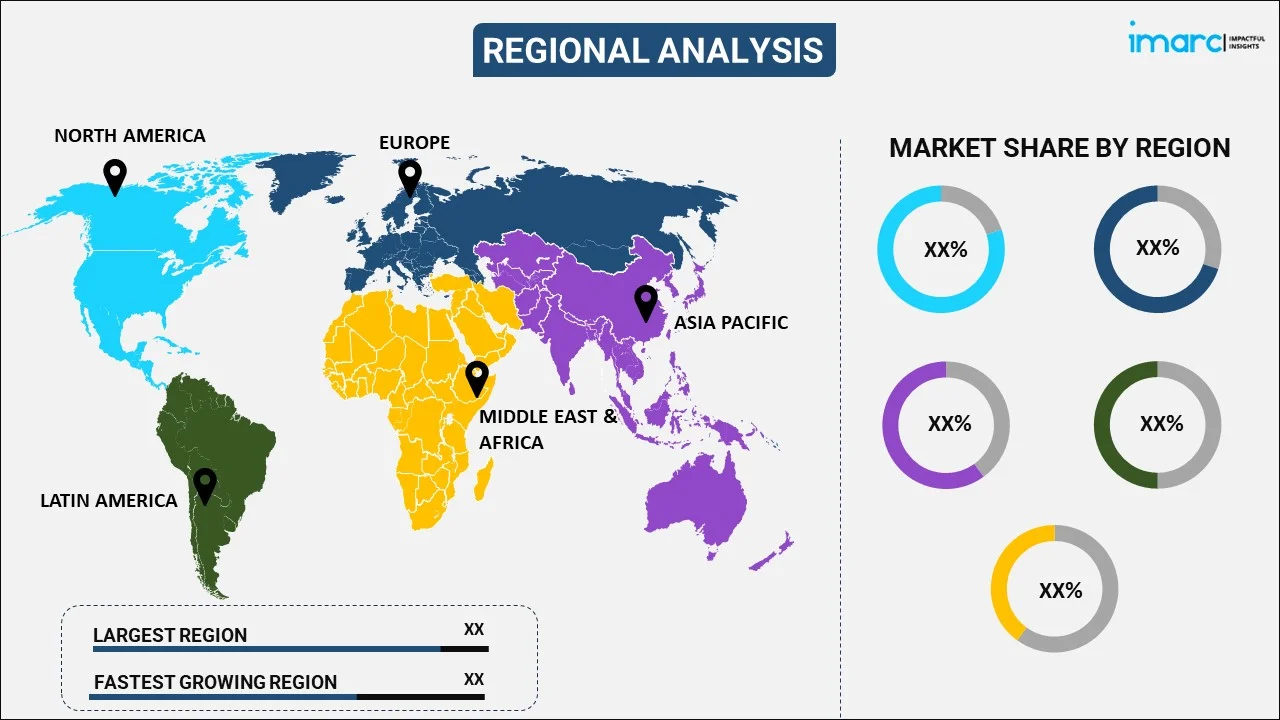
Peritoneal Dialysis Market Report by Treatment Type (Continuous Ambulatory Peritoneal Dialysis (CAPD), Automated Peritoneal Dialysis (APD)), Product (Peritoneal Dialysis Solution, Peritoneal Dialysis Devices, Peritoneal Dialysis Sets, Peritoneal Dialysis Catheters, and Others), End User (Home-based Dialysis, Dialysis Centers and Hospital-based Dialysis), and Region 2025-2033
Peritoneal Dialysis Market Size:
The global peritoneal dialysis market size reached USD 18.0 Billion in 2024. Looking forward, IMARC Group expects the market to reach USD 26.5 Billion by 2033, exhibiting a growth rate (CAGR) of 4.16% during 2025-2033. The market is being driven by the rising number of dialysis centers worldwide, the increasing government initiatives to promote kidney disease management, the growing adoption of continuous ambulatory peritoneal dialysis (CAPD), and the expanding healthcare infrastructure in developing countries. At present, North America holds the largest peritoneal dialysis market share, driven by favorable reimbursement policies and the rising geriatric population.
|
Report Attribute
|
Key Statistics
|
|---|---|
|
Base Year
|
2024
|
|
Forecast Years
|
2025-2033
|
|
Historical Years
|
2019-2024
|
|
Market Size in 2024
|
USD 18.0 Billion |
|
Market Forecast in 2033
|
USD 26.5 Billion |
| Market Growth Rate 2025-2033 | 4.16% |
Peritoneal dialysis (PD) represents a type of kidney failure treatment procedure wherein a soft plastic tube or catheter is placed in the abdominal lining or belly through surgery. Once it is positioned, a sterile cleansing fluid is transmitted by the duct that helps filter the blood inside an individual’s body by removing waste products. After a period of time, the liquid and filtered unwanted components flow out of the abdomen and are discarded. PD is differentiated into continuous ambulatory peritoneal dialysis and continuous cycling peritoneal dialysis (CCPD). These approaches offer treatment flexibility, reduce the need to visit dialysis centers, and provide better clinical outcomes, resulting in lesser medications and fewer food restrictions. Apart from this, it can be carried out at home and is needle-free; thus, PD is used by hospitals and healthcare centers to treat kidney failures.

Peritoneal Dialysis Market Trends:
Growing prevalence of end-stage renal disease (ESRD)
The growing prevalence of end-stage renal disease (ESRD) is a key factor driving the global peritoneal dialysis market growth as ESRD patients require dialysis or kidney transplantation to survive, with peritoneal dialysis emerging as a preferred treatment due to its convenience and home-based nature. According to the United States Renal Data System, there were 124,411 new ESRD diagnoses in 2015, with the disease increasing at about 20,000 cases per year. As the number of ESRD cases continues to rise globally, the demand for effective and accessible dialysis options, including peritoneal dialysis, increases. This trend is further supported by advancements in dialysis technologies, helping to meet the growing healthcare needs of the expanding ESRD population.
Increasing incidences of diabetes and hypertension
The rising incidences of diabetes and hypertension are significant drivers contributing to the augmenting peritoneal dialysis market share, as these conditions are the leading causes of chronic kidney disease (CKD) and end-stage renal disease (ESRD). Both diabetes and hypertension damage blood vessels and reduce kidney function over time, ultimately requiring dialysis or kidney transplantation for survival. With the global prevalence of diabetes and hypertension on the rise, particularly in aging population, there has been a corresponding increase in kidney failure cases. As a result, the demand for various dialysis treatments, including peritoneal dialysis, is escalating, thereby impelling the peritoneal dialysis market growth. This type of dialysis offers a convenient, home-based solution for patients, making it a preferred choice for managing kidney failure linked to these common health conditions.
Rising healthcare expenditures
Rising healthcare expenditures are also driving the market while enabling broader access to advanced dialysis treatments. As healthcare spending increases globally, especially in developed countries, more funds are allocated to managing chronic diseases like kidney failure. This allows for improved infrastructure, better-trained medical professionals, and access to cutting-edge peritoneal dialysis technologies. Additionally, according to the peritoneal dialysis market analysis report, increased healthcare budgets facilitate the adoption of home-based treatments, which can be more cost-effective and convenient compared to in-center hemodialysis. Government programs and insurance policies are also better positioned across numerous countries across the globe to support long-term dialysis care, thus easing the financial burden on patients and driving the demand for accessible, quality peritoneal dialysis solutions as part of comprehensive healthcare systems.
Peritoneal Dialysis Market Segmentation:
IMARC Group provides an analysis of the key trends in each segment of the market, along with forecasts at the global, regional, and country levels for 2025-2033. Our report has categorized the market based on treatment type, product, and end user.
Breakup by Treatment Type:

- Continuous Ambulatory Peritoneal Dialysis (CAPD)
- Automated Peritoneal Dialysis (APD)
Breakup by Product:
- Peritoneal Dialysis Solution
- Peritoneal Dialysis Devices
- Peritoneal Dialysis Sets
- Peritoneal Dialysis Catheters
- Others
Breakup by End User:
- Home-based Dialysis
- Dialysis Centers and Hospital-based Dialysis
Breakup by Region:

- North America
- United States
- Canada
- Asia-Pacific
- China
- Japan
- India
- South Korea
- Australia
- Indonesia
- Others
- Europe
- Germany
- France
- United Kingdom
- Italy
- Spain
- Russia
- Others
- Latin America
- Brazil
- Mexico
- Others
- Middle East and Africa
Competitive Landscape:
The report has also provided a comprehensive analysis of the competitive landscape in the global peritoneal dialysis market. Detailed profiles of all major companies have also been provided. Some of the companies covered include:
- Amecath
- Baxter International Inc.
- Fresenius Medical Care AG & Co. KGaA
- Medical Components Inc.
- Medionics International Inc.
- Medtronic plc
- Merit Medical Systems Inc.
- Mitra Industries Pvt. Ltd.
- Newsol Technologies Inc.
- Nipro Canada (Nipro Medical Corporation)
- Poly Medicure Limited
- Terumo Corporation
- Utah Medical Products Inc.
Kindly note that this only represents a partial list of companies, and the complete list has been provided in the report.
Peritoneal Dialysis Market News:
- October 10, 2024: Fresenius Medical Care announced that it is increasing its supply of IV fluids and peritoneal dialysis products in response to Hurricane Helene and is prioritizing the safety of patients and employees as Hurricane Milton approaches. The company has implemented a strategy to monitor and manage its supply chain, adjust prescriptions as necessary, and collaborate with alternative suppliers to mitigate any potential shortages resulting from Hurricane Helene’s disruption of Baxter International's manufacturing facility in western North Carolina.
- April 1, 2023: Medtronic plc and DaVita Inc. announced the launch of Mozarc Medical, a newly formed independent company focused on transforming kidney health through innovative, patient-centered technology solutions. The new entity aims to advance care in the renal health sector by leveraging both companies' expertise to address the changing needs of kidney patients.
Peritoneal Dialysis Market Report Scope:
| Report Features | Details |
|---|---|
| Base Year of the Analysis | 2024 |
| Historical Period | 2019-2024 |
| Forecast Period | 2025-2033 |
| Units | Billion USD |
| Segment Coverage | Treatment Type, Product, End User, Region |
| Region Covered | Asia Pacific, Europe, North America, Latin America, Middle East and Africa |
| Countries Covered | United States, Canada, Germany, France, United Kingdom, Italy, Spain, Russia, China, Japan, India, South Korea, Australia, Indonesia, Brazil, Mexico |
| Companies Covered | Amecath, Baxter International Inc., Fresenius Medical Care AG & Co. KGaA, Medical Components Inc., Medionics International Inc., Medtronic plc, Merit Medical Systems Inc., Mitra Industries Pvt. Ltd., Newsol Technologies Inc., Nipro Canada (Nipro Medical Corporation), Poly Medicure Limited, Terumo Corporation, Utah Medical Products Inc., etc. |
| Customization Scope | 10% Free Customization |
| Post-Sale Analyst Support | 10-12 Weeks |
| Delivery Format | PDF and Excel through Email (We can also provide the editable version of the report in PPT/Word format on special request) |
Key Questions Answered in This Report:
- How has the global peritoneal dialysis market performed so far, and how will it perform in the coming years?
- What has been the impact of COVID-19 on the global peritoneal dialysis market?
- What are the key regional markets?
- What is the breakup of the market based on the treatment type?
- What is the breakup of the market based on the product?
- What is the breakup of the market based on the end user?
- What are the various stages in the value chain of the industry?
- What are the key driving factors and challenges in the industry?
- What is the structure of the global peritoneal dialysis market and who are the key players?
- What is the degree of competition in the industry?
Key Benefits for Stakeholders:
- IMARC’s industry report offers a comprehensive quantitative analysis of various market segments, historical and current market trends, market forecasts, and dynamics of the peritoneal dialysis market from 2019-2033.
- The research report provides the latest information on the market drivers, challenges, and opportunities in the global peritoneal dialysis market.
- The study maps the leading, as well as the fastest-growing, regional markets. It further enables stakeholders to identify the key country-level markets within each region.
- Porter's five forces analysis assists stakeholders in assessing the impact of new entrants, competitive rivalry, supplier power, buyer power, and the threat of substitution. It helps stakeholders to analyze the level of competition within the peritoneal dialysis industry and its attractiveness.
- The competitive landscape allows stakeholders to understand their competitive environment and provides insight into the current positions of key players in the market.
Need more help?
- Speak to our experienced analysts for insights on the current market scenarios.
- Include additional segments and countries to customize the report as per your requirement.
- Gain an unparalleled competitive advantage in your domain by understanding how to utilize the report and positively impacting your operations and revenue.
- For further assistance, please connect with our analysts.
 Inquire Before Buying
Inquire Before Buying
 Speak to an Analyst
Speak to an Analyst
 Request Brochure
Request Brochure
 Request Customization
Request Customization




.webp)




.webp)












